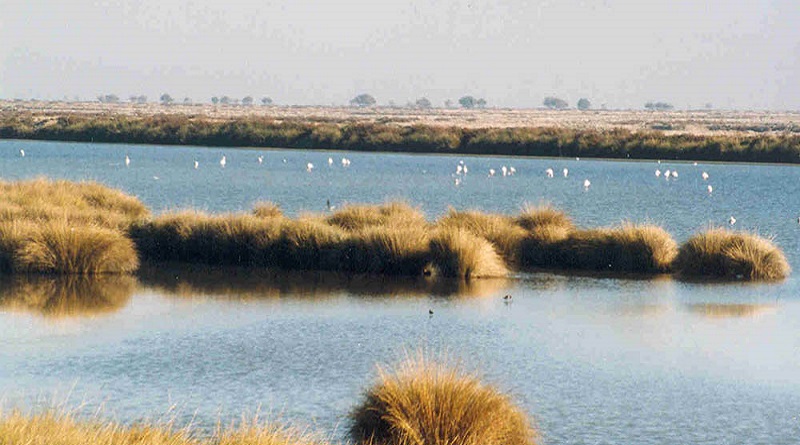Wetlands limit impact of floods, drought, cyclones- UNEP
Ahead of the year 2017 celebration of World Wetlands Day (WWD) which comes up on February 2, with the theme “Wetlands and Disaster Risk Reduction”, Johannes Refisch of the United Nations Environment Programme (UNEP), in this treatise outlined the importance of wetland in addressing floods, drought, and cyclones among other environmental issues.
Wetlands, as defined by the Ramsar Convention, include all lakes and rivers, underground aquifers, swamps and marshes, wet grasslands, peat lands, oases, estuaries, deltas and tidal flats, mangroves and other coastal areas, coral reefs, and all human-made sites such as fish ponds, rice paddies, reservoirs and salt pans.
They are highly productive ecosystems. They provide access to water for agricultural and domestic use. They make it possible for farmers to grow crops in rainy and dry seasons, thus increasing food availability. In addition, they are sources of materials for crafts and building. They provide grazing and watering for domestic and wild animals. They are a habitat for diverse flora and fauna, and serve as a lifeline for migratory birds.
They purify and replenish water, and are important for hydrological and climate regulation.
Humans depend on wetlands. This, combined with climate change, has often led to their exploitation and degradation.
It is estimated that over the last 100 years wetlands have declined by 64-71 per cent, leaving millions of people deprived of the essential services described above.
World Wetlands Day falls on 2 February. This year’s theme is “Wetlands and Disaster Risk Reduction”. It is the first time an International Day has an ecosystem-based disaster risk reduction theme.
In recent years the frequency of natural hazards has been increasing and the Intergovernmental Panel on Climate Change is predicting even more extreme events. This year’s Day aims to raise awareness and highlight the important role of wetlands in reducing the impacts of floods, droughts and cyclones on communities, and in helping to build resilience.
Did you know wetlands are nature’s shock absorbers and that 90 per cent of natural hazards are water-related? Wetlands act as natural sponges. They absorb rainfall, reducing floods and droughts. They reduce the speed and height of storm surges and tsunamis, and mitigate the impact of hurricanes. They are natural buffers, and if managed wisely reduce people’s exposure to storm surges, floods, drought and cyclones.
They can also support livelihoods and basic needs for food, water, shelter and fuel before, during and after disasters, thus strengthening resilience against disasters and climate change.
The Ramsar Convention is a partner institution of the Partnership for Environment and Disaster Risk Reduction, a global alliance of UN agencies, non-governmental organizations and specialist institutes that provides technical and science-based expertise and applies best practices in ecosystems-based disaster risk reduction.
From 2012-2016, the European Commission and UN Environment collaborated on a series of projects to promote, innovate and scale-up ecosystem-based approaches to disaster risk reduction (Eco-DRR) in vulnerable countries.
One of the main components of one such project on the south coast of Haiti was to plant 36,300 native mangroves and sea grape trees on the shoreline and river mouths. The project was titled Coastal Partners: Reducing Disaster Risk Through Sustainable Coastal Zone Management. Coastal vegetation serves as a natural barrier that can buffer against storm surges and strong winds, and thus provide added protection to residences and public infrastructure. It also provides stabilizing root structures that help mitigate beach erosion, which exacerbates the coastal impacts of storm surges, hurricanes and accelerated sea level rise. Recognizing the importance of coastal zone management for long-term sustainable and resilient development in Haiti, the project promoted Eco-DRR as part of broader efforts to strengthen coastal governance in the country.
“I am a market seller in Port Salut. I work in the nursery and at the same time I am a market seller. When the shrubs have grown, we remove them from the nursery and plant them near ravines and rivers. This way, when the water is high, the market will not be flooded, and I will always have a place to display my products,” said Roseline Moise, explaining the benefits of mangrove planting.
Rich with natural resources, the Democratic Republic of the Congo holds half of Africa’s freshwater sources. However, severe erosion and flooding are creating water-related hazards that impact Kinshasa and surrounding areas. This project promoted ecosystem-based measures, such as reforestation and vetiver planting, to mitigate gully erosion and floods and address ecosystem degradation, which is a driver of disaster risk in the Lukaya River Basin. The project was titled River Partners: Applying Ecosystems-based Disaster Risk Reduction in Integrated Water Resource Management in the Lukaya Basin, Democratic Republic of the Congo. It was funded by the European Commission and the UN Development Programme and implemented in collaboration with UN Environment and local partners.
Four tree nurseries were established producing 42,000 forestry and fruit tree seedlings per year. Vetiver bioengineering was piloted in the Basin to reduce gully and river bank erosion. Four vetiver nurseries were created, producing 32,000 vetiver plants per year. A green buffer zone was established at a water treatment plant near Kimwenza to reduce river bank erosion and sedimentation. Local risk monitoring systems were established and linked to the national monitoring system. Women were heavily involved in the project. As community leaders, farmers and breadwinners, they demonstrated high interest and showed strong engagement.
Wetlands provide valuable services for humans because they help protect the ecosystems upon which humans ultimately depend for their survival.
By UNEP



